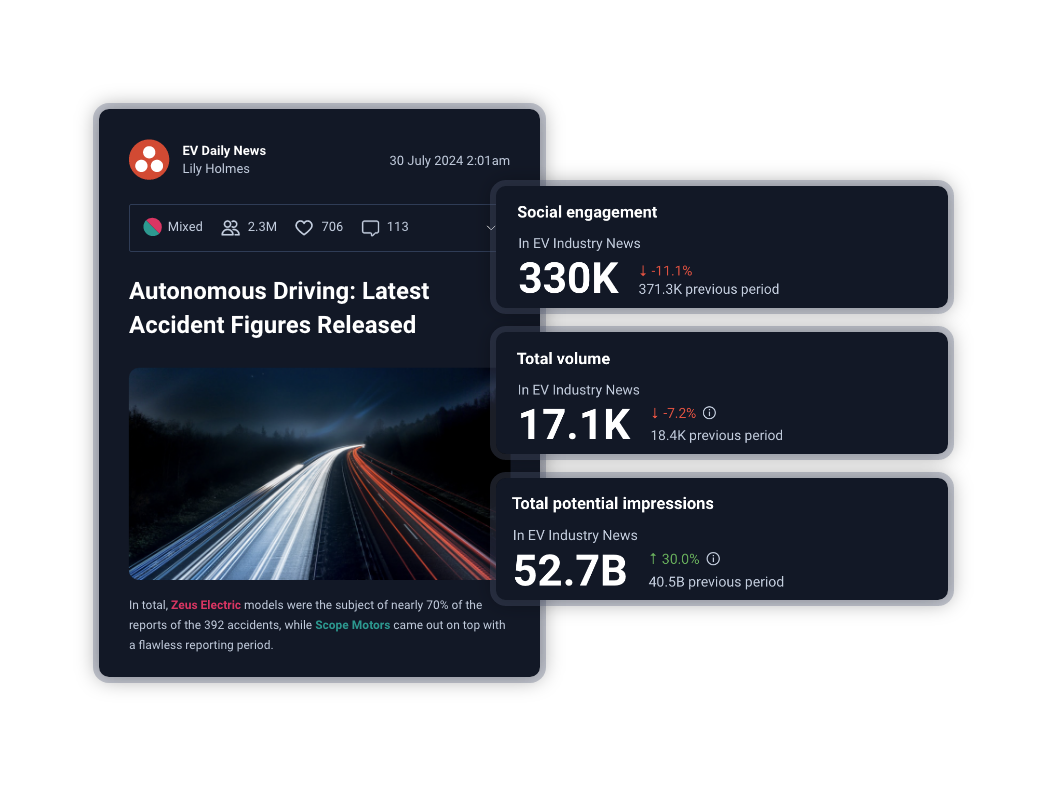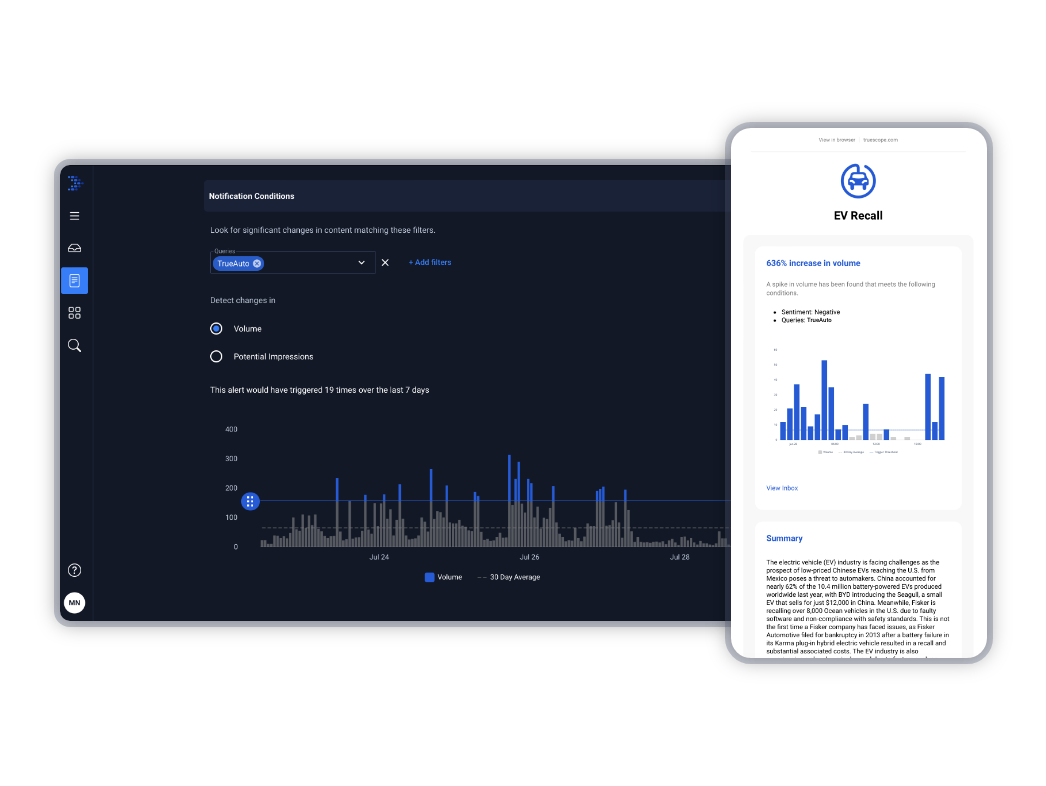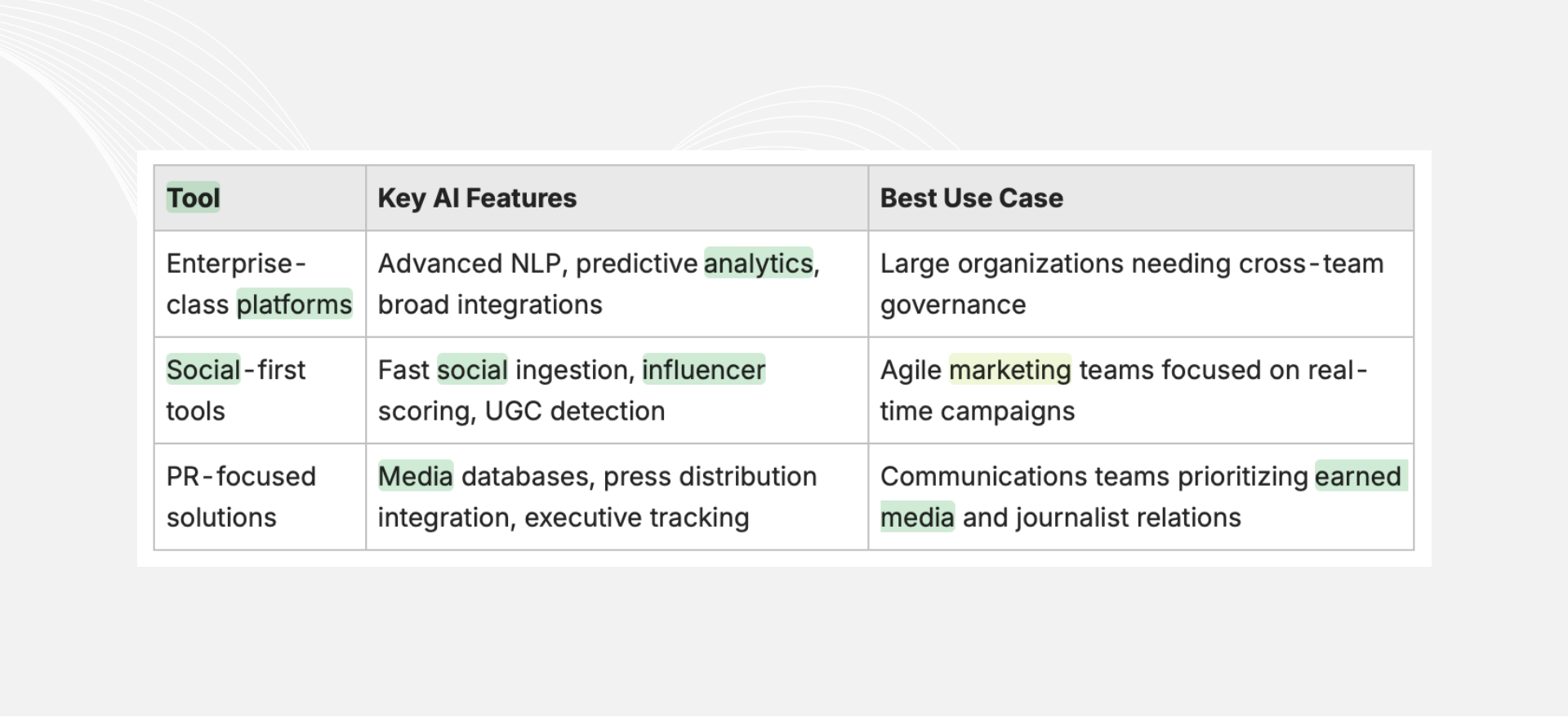
Media Monitoring in an AI Age: How AI Transforms Tools, Social Listening, Sentiment Analysis, and PR Monitoring
AI media monitoring refers to systems that ingest diverse media signals, apply machine learning and natural language processing to interpret content, and deliver actionable insights such as real-time alerts, sentiment classification, and trend detection. This article explains how AI transforms traditional media monitoring into scalable media intelligence capable of handling social media listening, sentiment analysis AI, and predictive analytics for PR teams. Readers will learn which core technologies power modern monitoring pipelines, how AI enhances accuracy and speed compared with manual methods, and practical guidance for selecting and integrating media monitoring tools into MarTech and PR stacks. We address benefits for campaign measurement, crisis readiness, influencer identification, and UGC tracking, and we surface ethical considerations around privacy, bias, and platform data access in the current 2025 landscape. The piece also provides a buyer-focused checklist, neutral comparison framework, and EAV tables that map AI features to outcomes to help teams evaluate AI media monitoring platforms and real-time media monitoring readiness.
What Is AI Media Monitoring and Why Is It Essential Today?
AI media monitoring is the automated process of collecting, analyzing, and surfacing media mentions across channels using AI models to convert raw signals into timely insights. This works by ingesting data from news, social media, forums, blogs, and multimedia, applying NLP and ML to extract entities and sentiment, and then prioritizing signals through alerting and trend-detection modules to speed decision-making. The result is improved situational awareness, faster time-to-detect for reputational issues, and the ability to measure campaign impact across earned media and social conversations. As media volume and formats expand, AI enables organizations to scale listening efforts without proportionally increasing headcount, making real-time media monitoring a strategic capability for communications and CX teams.
AI-powered media monitoring platforms commonly deliver core capabilities—real-time alerts, sentiment engines, and trend detection—that teams rely on during campaigns and crisis responses. If you want a hands-on look at how these capabilities perform in your environment, consider requesting demos or trialing platforms that emphasize customizable taxonomies and integration support. Understanding these baseline capabilities leads to a closer look at how monitoring evolved and the technologies that power modern systems.
How Has Media Monitoring Evolved with Artificial Intelligence?
Media monitoring evolved from manual clipping and keyword searches to automated scraping and now to AI-driven semantic understanding that interprets context and intent. Early automation accelerated collection and basic filtering, while NLP and supervised ML enabled entity extraction and basic sentiment classification; contemporary deep learning models add contextual analysis and multilingual support. This timeline shows a shift from volume-focused workflows to quality-focused insights, where AI reduces false positives and surfaces the most relevant signals for a given brand or topic. The contrast between manual and AI methods highlights why modern teams increasingly prioritize media intelligence platforms capable of semantic analysis and scalable workflows.
The next section examines the specific AI technologies that underpin these advances and how they apply directly to listening, sentiment, and multimodal monitoring.

What Are the Key AI Technologies Powering Media Monitoring?
Core technologies include Natural Language Processing for entity and topic extraction, machine learning for classification and clustering, deep learning for contextual understanding and multilingual models, computer vision for image and video recognition, and speech-to-text for audio sources. Together these technologies convert unstructured text, audio, and visual data into structured signals—entities, sentiment scores, and topic clusters—that drive alerts and dashboards. For example, NLP identifies mentions of a product and disambiguates brand references, while vision models detect logos in images and video frames to expand UGC tracking beyond text. These AI components form the meronymous parts of a platform: NLP models, sentiment engines, trend-detection modules, influencer databases, and real-time alerting systems.
Understanding these components clarifies how monitoring systems improve both speed and accuracy, which we explore next in concrete KPI terms.
How Does AI Improve Accuracy and Efficiency in Media Monitoring?
AI improves accuracy by using contextual models that reduce misclassification—handling negation, sarcasm, and polysemy better than keyword-only approaches—and efficiency by automating ingestion and triage workflows. Typical KPI improvements include reduced time-to-detect, higher precision in relevant mention filtering, and lower false-positive rates in alerting systems, which frees analysts to focus on response and strategy. Recent studies and market analyses in 2025 indicate that well-tuned AI pipelines reduce manual review volume significantly while maintaining or improving signal quality. These efficiency gains support faster escalation paths and more timely PR responses, which in turn helps protect brand reputation and optimize campaign attribution.
These accuracy and efficiency improvements directly support the expansion of AI into social listening capabilities and brand insight generation.
How Do AI Media Monitoring Tools Enhance Social Listening and Brand Insights?
AI media monitoring enhances social listening by automating the conversion of large conversational streams into prioritized insights about sentiment trends, influential voices, and emerging topics. This works through data ingestion from social platforms and forums, normalization, NLP-based topic modeling, and alerting that surfaces rapid changes in volume or tone. The output enables marketing, PR, and product teams to translate raw conversations into strategic actions such as campaign adjustments, influencer outreach, and product feedback loops. In practice, AI social listening improves the signal-to-noise ratio so teams can focus on high-impact conversations that affect brand health.
A closer look at the social listening pipeline helps clarify where influence and UGC tracking fit into this workflow.
What Is AI Social Listening and How Does It Work?
AI social listening is the continuous process of collecting social conversations, normalizing diverse data formats, applying entity extraction and sentiment analysis, and presenting trends and alerts for human review. The pipeline typically includes connectors to social platforms and news sources, data normalization to a common schema, NLP processing for entities and topics, and classification layers that tag content by issue, campaign, or sentiment. Outputs include dashboards, automated alerts, and exportable datasets for downstream analysis in analytics or CRM systems. This structured pipeline allows teams to act on consumer voice quickly and integrate insights into broader marketing and PR workflows.
From pipeline mechanics, we move to how the same systems identify influencers and verify user-generated content at scale.
How Does AI Identify Influencers and Track User-Generated Content?
AI identifies influencers by combining signals such as reach, engagement, topical authority, follower authenticity, and amplification patterns into a composite influence score. Algorithms rank creators by relevance to keywords or topics, cross-reference historical engagement, and flag suspicious amplification that might indicate inauthentic networks. For UGC tracking, AI uses keyword matching, image recognition, and contextual similarity to surface customer posts, reviews, and multimedia that contain brand references. A vetting checklist for automated influencer shortlists should include relevance to topical taxonomies, historical sentiment of mentions, engagement quality, and audience overlap to ensure fit with campaign goals.
These influencer and UGC capabilities support proactive trend detection, which we discuss next.
How Can AI Social Listening Detect Emerging Trends and Consumer Sentiment?
AI detects trends by measuring velocity, novelty, and volume changes across keywords and topics, using anomaly detection and clustering to surface emergent themes before they become widespread. Systems compute trend scores that combine growth rate, distribution across channels, and sentiment shifts to prioritize alerts. Practical workflows pair trend alerts with suggested next actions—such as targeted outreach, creative refresh, or escalation to crisis teams—to convert early signals into tactical responses. Effective trend detection requires tuning thresholds and having human-in-the-loop validation to reduce noise and refine taxonomy mappings over time.
These social listening outputs feed directly into sentiment analysis practices, which the next section unpacks in depth.
What Are the Benefits of Sentiment Analysis with AI in Media Monitoring?
AI sentiment analysis measures public opinion and emotional tone by mapping language patterns to polarity scores and discrete emotion categories, enabling teams to quantify brand perception at scale. Models use contextual embeddings and fine-tuned classifiers to handle negation, sarcasm, and multilingual content, producing more nuanced sentiment than keyword dictionaries. The outcomes include improved campaign measurement, earlier detection of negative narratives, and quantified executive reputation metrics that inform strategy. These measurable benefits make sentiment analysis AI a central component of media monitoring and brand reputation management.
Below is a table that links sentiment analysis benefits to AI mechanisms and expected outcomes to help decision-makers evaluate ROI and operational impact.
Introductory summary: The table below maps common sentiment benefits to underlying AI mechanisms and the outcomes organizations can expect when deploying sentiment analysis in monitoring workflows.

How Does AI Sentiment Analysis Measure Public Opinion and Emotional Tone?
AI measures opinion by converting text into vector representations, then applying classifiers or regression models to assign polarity and emotion labels, often complemented by intensity scoring. Modern systems include emotion taxonomies (e.g., anger, joy, fear) and contextual modifiers to handle sarcasm and multi-clause sentences, improving accuracy over basic polarity. Multilingual models and transfer learning help maintain consistent sentiment scoring across languages and regions. These mechanisms enable teams to quantify opinion shifts and track emotional drivers behind consumer behavior.
How Accurate Is AI Compared to Manual Sentiment Analysis?
AI provides scale and consistent baseline accuracy but can struggle with nuanced or cultural context that human coders handle better; hybrid approaches combine automated scoring with periodic human validation. Typical implementations show AI matching or exceeding human inter-rater reliability on common sentiment categories while offering far greater throughput. Best practices include continuous model tuning, annotation of edge cases, and sampling for manual review to maintain calibration. This hybrid model preserves the efficiency of AI while leveraging human judgment for complex or high-stakes content.
What Are Common Use Cases of Sentiment Analysis in PR and Brand Reputation?
Sentiment analysis supports campaign measurement, crisis detection, competitor benchmarking, and executive reputation monitoring with quantifiable metrics that inform strategic decisions and tactical responses. Use-case vignettes include: correlating sentiment spikes to a product launch for attribution; detecting rising negative sentiment to trigger crisis playbooks; benchmarking brand sentiment against competitors for positioning; and tracking executive mentions to manage leadership reputation. Each use case benefits from clearly defined KPIs—such as sentiment lift, time-to-detect, and share-of-voice—to demonstrate impact.
These PR applications naturally lead into AI’s role in proactive monitoring and crisis management, which we examine next.

How Is AI Transforming Public Relations Monitoring and Crisis Management?
AI transforms PR monitoring by enabling proactive crisis detection, predictive scenario planning, and more efficient operationalization of insights into response workflows. Systems combine early-warning signals, predictive amplification risk scores, and prioritized escalation pathways to help PR teams act before issues escalate. This shift moves organizations from reactive triage to evidence-driven foresight, allowing PR and communications leaders to plan scenario-based responses and resource allocations. Understanding predictive capabilities clarifies how AI outputs integrate into strategy and day-to-day PR operations.
Below is a table linking predictive capabilities to input data and practical PR applications to illustrate how AI models turn signals into actions.
Introductory summary: The following table explains common predictive features, the inputs they require, and practical PR applications to turn predictions into operational plans.

How Does AI Media Monitoring Support Proactive Crisis Detection?
AI supports proactive crisis detection by defining detection signals—rapid volume spikes, sentiment deterioration, emergence of high-reach mentions—and mapping them to escalation thresholds and triage workflows. Detection pipelines can route high-risk items to designated response teams, include suggested talking points based on historical successful responses, and feed incident-tracking systems for auditability. Key KPIs include time-to-first-alert, percentage of true positives, and median time-to-resolution. By automating triage and routing, AI reduces reaction time and helps teams focus on strategic communications rather than manual sorting.
From detection, teams use predictive analytics to anticipate scenario developments and shape strategy, discussed next.
What Role Does Predictive Analytics Play in PR Strategy Development?
Predictive analytics forecasts sentiment shifts and amplification likelihood, enabling PR teams to stress-test messages and allocate resources proactively. Models can simulate how different narratives might amplify based on influencer networks and audience sentiment, helping teams choose messaging and timing that minimize risk. Practical outputs include probability scores and suggested scenarios, which teams can incorporate into crisis playbooks and contingency budgets. Integrating these forecasts into planning cycles improves readiness and reduces surprises during high-impact events.
Predictive insights also feed into longer-term reputation management to maintain steady brand narratives across channels.
How Does AI Help Manage Brand Reputation in a Rapidly Changing Media Landscape?
AI helps manage reputation through continuous monitoring, cross-channel synthesis of signals, and longitudinal dashboards that track brand health over time. By correlating mentions across news, social, and multimedia, platforms reveal persistent narratives and their drivers, allowing teams to address root causes rather than superficial symptoms. Executive-level dashboards aggregate entity-level metrics for leadership review, while team-level tools provide actionable items for operations. This combination of continuous observation and synthesized insights supports sustained reputation strategies that adapt to fast-moving media conditions.
With PR operations clarified, organizations must evaluate tools and integration strategies, which the next section addresses with feature checklists and a neutral comparison framework.
Which AI Media Monitoring Tools Are Leading the Market and How to Choose the Best?
Choosing the right AI media monitoring solution requires evaluating coverage, NLP quality, alerting, integrations, and support for multimodal sources. Essential selection criteria include data-source breadth (social, news, forums, broadcast), NLP accuracy and customization, real-time alerting and escalation, integration with CRM and analytics stacks, and API access for automation. Buyers should map these features to organizational priorities—enterprise readiness, social-first agility, or PR-focused reporting—and pilot platforms with representative queries to verify performance. Below is a practical checklist to guide vendor evaluation before committing to a trial or proof-of-concept.
The checklist below outlines must-have features and why they matter to help procurement and comms teams compare platforms quickly.
- Data Coverage: Ensure the vendor ingests the channels and languages you need for global campaigns.
- NLP Quality and Custom Taxonomy: Confirm the platform supports custom rules and entity disambiguation for your brand.
- Real-Time Alerts and Escalation: Verify latency and routing options for immediate incident handling.
- Integrations and APIs: Check connectors for CRM, analytics, and ticketing systems to enable workflow automation.
- Multimodal Support: Evaluate image, video, and audio analysis capabilities if UGC multimedia matters to your brand.
This checklist helps buyers prioritize features during demos and pilot tests; after evaluating feature fit, teams should request demos or contact vendor sales for tailored integration guidance.
Introductory summary: The table below compares representative tool types by key AI features and suggested best use cases to assist neutral decision-making without vendor endorsement.

What Essential Features Should You Look for in AI Media Monitoring Platforms?
Essential features include comprehensive coverage, high-quality NLP with customization, low-latency alerting, robust integrations (APIs, CRM, analytics), and support for multimedia analysis to capture video and audio mentions. Coverage determines how complete your listening is; NLP quality affects accuracy of topics and sentiment; alerting impacts response speed; and integrations enable operational workflows and reporting. Prioritize features based on your objectives—crisis monitoring, campaign measurement, or influencer programs—to avoid overpaying for unused capabilities. A pragmatic pilot should test each essential feature against representative use cases.
Having listed essentials, it’s useful to understand differences in positioning among common tool categories, which we covered in the comparison table above.
How Can You Integrate AI Media Monitoring with Existing PR and Marketing Stacks?
Integration points commonly include CRM systems for lead and influencer records, analytics platforms for cross-channel attribution, ticketing systems for incident workflows, and BI tools for executive dashboards. Practical tips include using APIs for near-real-time syncing, mapping taxonomy fields to CRM segments, and automating rule-based routing to ticketing or incident-management systems. Data governance practices—clear field mappings, retention policies, and access control—ensure consistent use of monitoring outputs. Start by piloting a single integration (e.g., alerts to ticketing) and expand based on proven value.
With integration approaches in hand, teams should also plan for future trends and ethical responsibilities in AI monitoring, discussed next.

How Will Video, Audio, and Immersive Monitoring Shape the Future of Media Intelligence?
Video and audio analysis expand monitoring beyond text by enabling transcription, speaker identification, and scene recognition, which capture brand mentions hidden in multimedia. Emerging immersive sources—AR/VR spaces and streamed events—will add new channels for reputation signals and require low-latency processing and robust compute resources. Technical challenges include transcription accuracy, speaker diarization, and the compute and storage demands of processing large media files at scale. As multimodal monitoring matures, organizations that incorporate these capabilities will gain fuller picture of UGC and broadcast mentions, but must plan for increased resource and governance needs.
AI-Powered Social Listening for Crisis Management and Communication
The convergence of artificial intelligence (AI) and social listening has redefined crisis management in the technology sector, enabling organizations to detect, interpret, and respond to emerging threats with unprecedented speed and contextual precision. While prior research has examined AI in communication and monitoring separately, there remains a literature gap in synthesizing how AI-powered social listening operates across the whole crisis lifecycle and aligns with established communication theories such as Situational Crisis Communication Theory (SCCT). This paper addresses this gap through a systematic literature review (SLR) of 68 peer-reviewed studies published between 2013 and 2024, identifying key technological capabilities, applications, limitations, and ethical considerations. Findings indicate that transformer-based natural language processing (NLP) models, multimodal AI, and advanced anomaly detection systems significantly enhance early warning capabilities
AI-Powered Social Listening for Strategic Crisis Management in the Digital Era, 2025
How Can Human-AI Collaboration Enhance Media Monitoring Outcomes?
Human-AI collaboration combines AI scalability with human judgment: humans validate edge-case outputs, refine taxonomies, annotate training data, and make strategic calls that models cannot. Operational processes for continuous improvement include feedback loops where analysts correct model outputs and those corrections feed retraining datasets, regular calibration meetings to align taxonomy with business goals, and designated escalation points for sensitive cases. Structuring human review for high-risk categories preserves efficiency while ensuring nuanced interpretation where it matters most. This hybrid approach maintains accuracy, accountability, and adaptability as media and AI models evolve.
What Are the Most Common Questions About AI Media Monitoring?
This FAQ-style section provides concise, practical answers to common queries about AI’s role, benefits, tools, and future in media monitoring. The answers synthesize earlier sections into short, actionable responses ideal for quick reference by decision-makers and practitioners. Each answer highlights the mechanism, a specific benefit, and a suggested next step for teams evaluating AI readiness or piloting a platform.
How Does AI Help in Media Monitoring?
AI automates collection, classification, and prioritization of media mentions by applying NLP and ML to convert unstructured data into structured insights and alerts. This reduces manual review time and improves detection of relevant patterns like sentiment shifts or emerging topics. The result is faster situational awareness and more targeted allocation of PR and marketing resources. Teams should pilot representative queries to confirm accuracy and tune taxonomies before full deployment.
What Are the Benefits of AI in Social Media Listening?
AI social listening delivers real-time consumer insights, automated influencer identification, and sentiment tracking that scale across languages and channels. These capabilities let teams detect trends early, measure campaign resonance, and target outreach efficiently. Implementing AI listening improves response speed and provides data for strategic decisions across marketing, PR, and product teams. Start by defining priority channels and keywords to validate platform coverage during a demo.
How Is AI Transforming Public Relations?
AI enables proactive monitoring, predictive scenario planning, and automated triage that speed responses and provide evidence-based strategy adjustments. Applications include crisis early-warning, message optimization, and executive reputation tracking, backed by quantifiable KPIs like time-to-detect and sentiment lift. Integrating AI outputs into PR playbooks and ticketing systems operationalizes insights for faster, coordinated responses across teams.
What Is the Future of Media Intelligence with AI?
The future emphasizes multimodal coverage—video, audio, immersive content—tighter data governance due to platform changes, and more predictive analytics that forecast narrative trajectories and reputational impact. Ethical AI practices and human-in-the-loop processes will become standard to ensure transparency and reduce bias. Teams that test multimodal pilots and institute robust governance will be better positioned to leverage next-generation media intelligence.
Final recommendation and next step: assess your organization's AI readiness by mapping priorities to the feature checklist above, request demos to validate coverage and NLP performance with real queries, and consider creating a buyer's checklist that includes data governance and integration requirements to guide procurement and pilot decisions.





